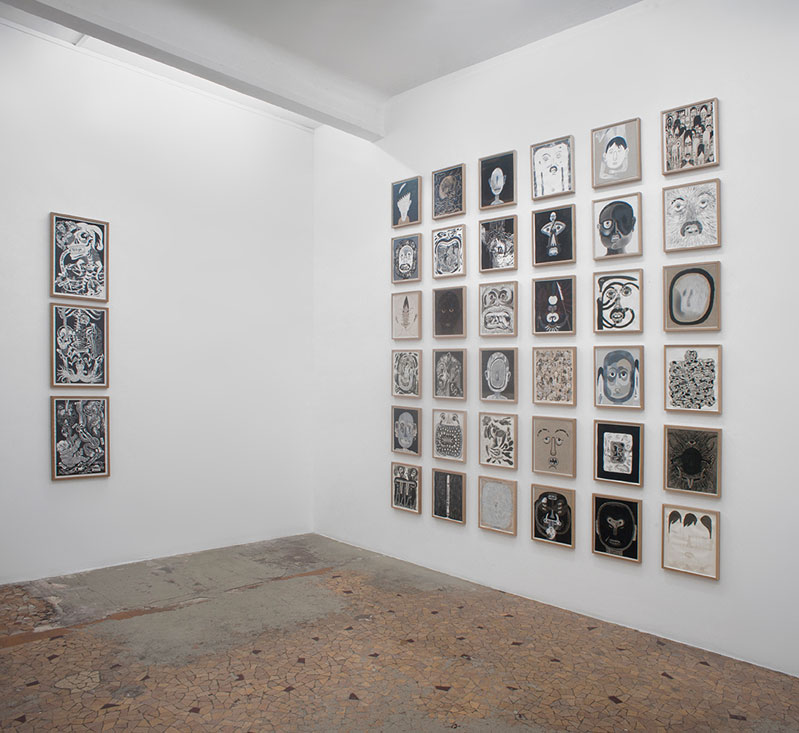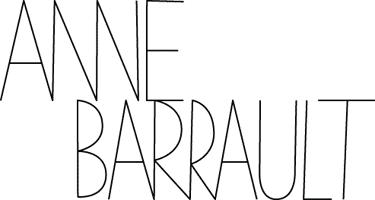Gallery Anne Barrault is pleased to present a new exhibition of David B. entitled “Mon Frère et le Roi du Monde” (My Brother and the King of the World), including an exceptional set of 72 drawings. This project follows the last two solo exhibitions of the artist at the art centre le Pavillon Blanc in Colomiers and at the Museum of l’Abbaye Sainte-Croix in les Sables d’Olonne, as well as the book published by l’Association. David B.’s new works will also be shown.
In my parents’ bookcase there was a small book, with a white cover like a desert, with only the title, the name of the author, that of the collection and of the publisher, and a small line drawing from a medieval illustration showing Abraham in front of Melkistedeq. It had been written by René Guénon in 1927, and was entitled “The King of the World”.
I immersed myself in its reading, a dense, laborious, labyrinthine reading, in which the mythical figure of the King of the World slipped away along the chapters, instead of revealing itself. I was unsatisfied, craving for a figure with huge power, a wizard king soothing the pains of the world, a king making desolate countries grow green again, someone I would have been unaware of and whom this book would have made me discover.
Eventually the book was more of a riddle than solving a mystery.
I was 12 years old, and my elder brother had known very violent epileptic fits, which regularly swept him along for long minutes.
No doctor had been able to cure him; the cause of his illness was not known, and my trust in the adult world, in whatever authority, was knocked down, like my brother during his fits.
And these fits were like clocks; at that time he had them three times a day, and I was always the first one to see them happen. I kept quiet, I scrutinized the disease gaining ground, and it always began in this way: the illness stopped him, rooted him and took his place, it crawled under the skin of his face and disfigured him all at once in a slow and continuous groan. We rushed to prevent him from falling, and waited around him till he recovered from his fit, a recovery which most of the time lasted a few minutes, but could last an hour.
So I have lost my big brother. I have seen him lose his energy with the fits, the wounds and the medicines,. He no longer ran, did not climb trees any more with me, we no longer drew together, and when we fought, he never had the advantage. Then he had a fit, and he fell down, and a big brother who falls, and who must be picked up is no longer your elder brother.
I soon realised, malicious as any child, that I was able by laughing at him, to provoke a fit, and to see him
collapse on the ground to my will. I had therefore the power, and I did not know what to do with it, it hindered me, it hampered me, because I had not wanted it, it happened when all my illusions fell around me.
My parents’ bookcase stood from floor to ceiling, and I literally climbed it, with my feet and my hands I clang to the edges of the shelves to reach the highest shelf on which the most specialized books about esotericism and symbolism laid. This is where, hanging between sky and earth, I discovered “Le Roi du Monde” (The King of the World). That was exactly what I needed at that time, I was sure to find in it the answers to the muddled questions, which haunted me: The King of the World was my man, the man for the job. I jumped off the bookcase as I always did. This was a ritual, a jump into the void, an end, for the time being, of my search among books, and I was back on the floor with my problems.
What about this King of the World? I was not disappointed; I was at my wits’ end.
He added mystery when I was looking for light. But the cat that was me and haunted the garden at night did not mind.
I had given him a face at once. My father had read the magazine “Planète” the issues of which he kept somewhere, and their covers had fascinated me. Every time, there was the face of an ancient or oriental statue, or an African or Melanesian mask, a face covered with ritual painting, and all these faces in these issues fascinated me greatly.
I constantly scrutinized them to try to understand some of the world diversity and complexity. Each of these faces has been for me one of the looks of the King of the World.
The book itself had a face, its cover.
The title, on the top, like eyebrows, the small drawing, like an only eye, the logo of the publisher for a mouth, the word Gallimard drawing a crease on the chin, and the King of the World, a white Cyclops full of promises, was looking at me.
In “le Cheval Blême”, my first book published by l’Association, there is a dream entitled “Death and its Work”, in which death changes appearance in each box. I was quite surprised to find in this nightmare something of the succession of the faces on the covers of the magazine Planète. I had another dream, of the same unconscious kind, which I placed at the end of “l’Ascension du Haut Mal”, during our cavalcade, when my brother, dead, is metamorphosed into the thousand faces of death.
Over the years, I have paid attention to the way his illness and its consequences have affected and transformed his body and his face: the wounds because of his falls, then the scars, the losing of teeth and hair, weight gain because of the lack of exercise, the blue helmet he wore for some time to avoid shocks, sores and bruises, the moustache, the long hair, the shaven head, the broken and patched up glasses, then, after the accident due to a fit which left him half paralysed, the skinniness once more after he refused to eat.
It occurred to me quite early to draw something that would evoke one by one each fit of my brother, to draw them one after the other; a titanic work, and I am not a Titan. I limited myself to 72, this number is my tribute to esotericism, and it is the number, like all those around 70, which symbolizes entirety; besides, according to the Hadiths of the Prophet Muhammad, there are 72 diseases, and you must take salt before and after a meal to prevent them. Moreover, when we had electroencephalograms at the beginning of my brother’s disease, the nurse put salt on our hair, because it increased the quality of the exam. And so on.
These portraits jump from one subject to another.
They are the images of the loss of power faced with omnipotence.
In this book, the portraits face each other, one of my brother’s opposite one of the King of the World’s.
In the exhibition in Pavillon Blanc in Colomiers my brother’s 36 portraits are all together on a board; facing them on another board there are those of the King of the World.
In l’Abbaye de Sainte Croix in les Sables d’Olonne, they will still be opposite, but each set of the 36 portrait will be on one line. In gallery Anne Barrault, the layout will be once again different. Beside, this series will still have another shape.
And I like to think that this exhibition of metamorphoses still changes each time too.
Talking with my mother while looking at the photographs of my brother now, in his wheelchair, with the drip feeding him, and she tells me he has become the King of the World.
Maybe.
David B.
6 November 2015

© Alberto Ricci

© Alberto Ricci
